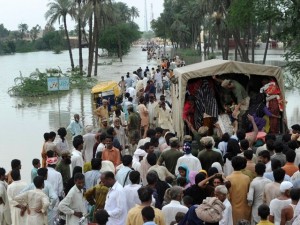Flood effectees of Sindh: Things that need to be done
Tuesday, February 7th, 2012 3:04:21 by Naveed A Bari
Flood effectees of Sindh: Things that need to be done
Heavy rainfall in August 2011 caused significant devastation across Pakistan. The hardest hit province is Sindh, with 22 out of 23 districts affected. As of 3rd September, the worst-affected districts are Badin, Mirpurkhas, and Tando Muhamad Khan,
although damage assessments are still underway.
PDMA estimates that 4.9 million people have been affected in 22 districts across Sindh. An estimated 300,000 people have been displaced in District Badin of Sindh Province. According to authorities, more than 90,000 affectees are now in relief camps, and
in dire need of shelters and food. The situation is the same in Mirpurkhas and Tando Muhammad Khan. In Tando Muhammad Khan the total affectees are 267,368.
Partially damaged houses are estimated at 24,200 and fully damaged houses are 26,600 in number, with an assumed correlated destruction in assets. Similarly in Mirpurkhas, the damages are high with 275,000 people displaced and more than 500,000 people flood-affected.
There are 113 relief camps established to date in Mirpurkhas. However, most affected people can be found in spontaneous settlements beside main roads and relatively safe areas of the districts.
Settlements exhibit poor conditions and IDPs in these contexts are under extreme duress about their situation due to approaching harsh winters which will usher in more extreme emergency conditions unless immediate lifesaving efforts in health, nutrition,
food security, protection, shelter, and WASH are met with onward recovery interventions to stabilize household welfare.
Program design, implementation, and mitigation strategies are based on the following critical assumptions:
- The existence of a functioning government and continued NOC and other access permissions granted
- Reasonable stability in the security situation. Current conditions are permissive; however, temporary deteriorations of the security situation can have an impact on activities requiring course correction with donor consult.
- Development of strong collaborative relationships with proposed program beneficiary and local grassroots leaders.
- Continued positive coordination with other humanitarian agencies working in the region.
- Ability to convene or seek input from all key stakeholders across gender and vulnerability lines, without compromising safety and security of participants.
- Effective environmental access to beneficiary populations
- Effective program management in Pakistan is contingent upon effective environmental access to vulnerable populations.
- There is adequate human resource capacity in the target community for recruitment and project management execution across the project timeline.
Short URL: https://www.newspakistan.pk/?p=11968

















